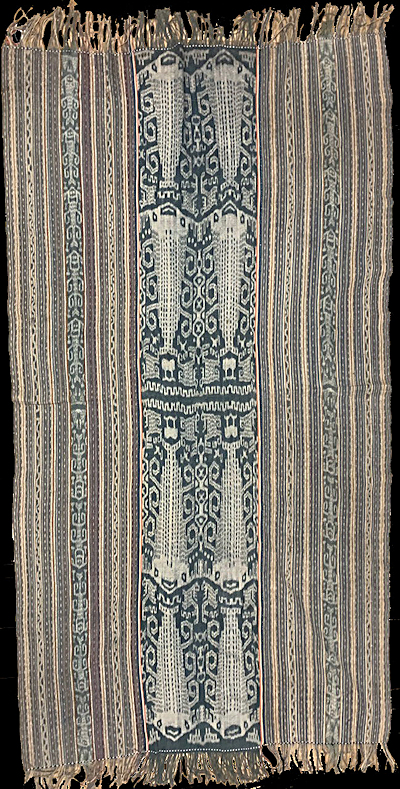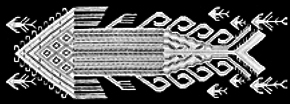| |
 

LEFT THE COLLECTION
display continued to support resarch | | | |
360 Timor, West Timor
Mau naek (men's wrap) 
| | Locale: | Bokong, North Amanatun | | Period: | 1945 | | Yarn: | Cotton, hand-spun, medium, irregular, degraded | | Technique: | Warp ikat | | Panels: | 2 | | Size: | 103 x 194 cm (3' 4" x 6' 4") LW: 1.88 | | Weight: | 880 g (31.0 oz), 440 g/m2 (1.44 oz/ft2) | | Design: | The central band is decorated with six large river fish, drawn in great detail. The secondary ikated bands carry human figures which appear to wear the meo warrior's headgear, pilu saluf. The fish motif is best described in the words of Pierre Dugard (from his contribution to Peter ten Hoopen, ed., Timor: Totems and Tokens: 'While one would expect to find the image of the fish in the coastal areas, it is only in the mountain district of North Amanutan, and restricted to a small number of communities, that it can be found. [...] It is rather a paradox, since no fish-filled river or waterway runs through North Amanatun'. There is a legend, however: 'River fish are still crocodiles� favourite food. They are so eager to feed on them that they sometimes venture up the river Benain, coming from the sea, until they reach the foothills of our mountains, where during the rainy season they can find abundant fish. A long time ago, a saltwater crocodile helped our great ancestor to reach our island, carrying him on his back. That is why we so often represent, in the garments woven by our women, this food so coveted by the crocodiles'. | | Comment: | [PHOTOGRAPHY PROVISIONAL] The microphotography shows the use of the wildly irregular yarn that is characteristic of the period before circa 1925 and rarely encountered in younger ikat. The marked yarn degradation (click on the microcope) suggests intensive use. Commensurately, the colours are a bit wished out, but enough contrast remains to let us see the fascinating, well executed pattern with its uncommon link to one specific region. Actually, it is not clear how much colour was actually lost. Clearly the cloth was made the have three different shades of blue: dark pinstripes, a medium midfield, and noticeably paler secondary ikat bands. Note the very fine stippling of the fishes' backs, created by countless tiny, very tight ties. It is this type of work that reminds us that for women of the island, and the wider region around it, economy was not what they were after. They wanted to show off their skills, as this weaver did with its technically impeccable execution of the motif. All natural colours, corded fringes. | | Background: | Chapters on Timor and West Timor. | | Sources: | Motifs similar to those on specimen in Yeager & Jacobson, Textiles of Western Timor, Plate 260, but with six instead of three fishes and more intricate drawing overall. For a description of the motif see Pierre Dugard, 'Motifs hidden inside motifs', in Peter ten Hoopen, ed., Timor: Totems and Tokens. Below is one of Dugard's beautifully detailed drawings of North Amanatun fish motifs.
 | | |

©Peter ten Hoopen, 2025
All rights reserved.
|
|


